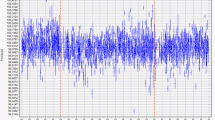Abstract
We present a general relativistic model of a spherical shell of matter with a perfect fluid on its surface coupled to an internal oscillator, which generalizes a model recently introduced by the authors to construct a self-gravitating interferometer (Gooding and Unruh in Phys Rev D 90:044071, 2014). The internal oscillator evolution is defined with respect to the local proper time of the shell, allowing the oscillator to serve as a local clock that ticks differently depending on the shell’s position and momentum. A Hamiltonian reduction is performed on the system, and an approximate quantum description is given to the reduced phase space. If we focus only on the external dynamics, we must trace out the clock degree of freedom, and this results in a form of intrinsic decoherence that shares some features with a proposed “universal” decoherence mechanism attributed to gravitational time dilation (Pikovski et al in Nat Phys, 2015). We note that the proposed decoherence remains present in the (gravity-free) limit of flat spacetime, emphasizing that the effect can be attributed entirely to proper time differences, and thus is not necessarily related to gravity. Whereas the effect described in (Pikovski et al in Nat Phys, 2015) vanishes in the absence of an external gravitational field, our approach bootstraps the gravitational contribution to the time dilation decoherence by including self-interaction, yielding a fundamentally gravitational intrinsic decoherence effect.
Similar content being viewed by others
Notes
Of course, quantum fluctuations of the center-of-mass motion would still produce decoherence in the momentum basis for the reduced system; similarly, for our shell system in the absence of both gravity and pressure, the effective interaction (43) would lead to decoherence in the momentum basis of the reduced system. In both of these cases the decoherence basis would not involve the position, so it would be difficult to imagine how to observe such a decoherence using standard techniques such as interferometry.
References
Gooding, C., Unruh, W.G.: Self-gravitating interferometry and intrinsic decoherence. Phys. Rev. D 90, 044071 (2014)
Pikovski, I., Zych, M., Costa, F., Brukner, C̆.: Universal decoherence due to gravitational time dilation. Accepted for publication in Nature Physics, (2015). doi:10.1038/nphys3366. arXiv:1311.1095
Zych, M., Costa, F., Pikovski, I., Brukner, C̆.: Quantum interferometric visibility as a witness of general relativistic proper time. Nat. Commun. 2, 505 (2011). arXiv:1105.4531v2
Zych, M., Costa, F., Pikovski, I., Ralph, T.C., Brukner, C̆.: General relativistic effects in quantum interference of photons. Class. Quantum Grav. 29, 224010 (2012). arXiv:1206.0965v2
Stamp, P.C.E.: The decoherence puzzle. Stud. Hist. Philos. Mod. Phys. 37, 467 (2006)
Arnowitt, R.L., Deser, S., Misner, C.W.: Canonical variables for general relativity. Phys. Rev. 117, 1595 (1960). arXiv:gr-qc/0405109
Kraus, P., Wilczek, F.: Self-interaction correction to black hole radiance. Nucl. Phys. B 433, 403 (1995). arXiv:gr-qc/9408003v1
Walls, D., Milburn, G.: Quantum Optics. Springer, Berlin (1994)
Penrose, R.: On gravity’s role in quantum state reduction. Gen. Relativ. Gravit. 28, 581–600 (1996)
Diósi, L.: Models for universal reduction of macroscopic quantum fluctuations. Phys. Rev. A 40, 1165–1174 (1989)
Acknowledgments
The authors would like to thank the Natural Sciences and Engineering Research Council of Canada (NSERC) and the Templeton Foundation (Grant No. JTF 36838) for financial support. Also, we are grateful to the Aspelmeyer and Brukner groups at the University of Vienna, as well as Friedemann Queisser, Dan Carney, Philip Stamp, and Bob Wald, for stimulating discussions.
Author information
Authors and Affiliations
Corresponding author
Rights and permissions
About this article
Cite this article
Gooding, C., Unruh, W.G. Bootstrapping Time Dilation Decoherence. Found Phys 45, 1166–1178 (2015). https://doi.org/10.1007/s10701-015-9939-9
Received:
Accepted:
Published:
Issue Date:
DOI: https://doi.org/10.1007/s10701-015-9939-9



